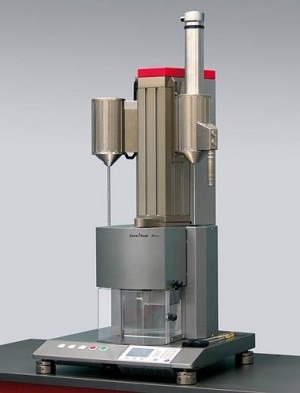
Zwick has presented its Aflow extrusion plastometer to industry specialists for the first time at the 18th Testxpo international testing technology forum.
Designed for 50kg test loads, the Aflow presents a compact appearance.
'The instrument uses state-of-the-art force control in place of the usual individual weights,' said Florian Liebert, who oversaw development of the Aflow plastometer.
This technology is claimed to make melt index determination easier and more reliable.
It offers the option of controlling the start position specified in the standards by means of superimposed force and speed control.
At the start of measurement the instrument identifies the amount of polymer in the extrusion barrel and determines independently, on the basis of pre-set limit values, the load to be used in the pre-heating phase.
This is an advantage when polymers with unknown MFR are being tested, and also when operators have not adhered precisely to the specified charge quantity.
Load application via electromechanical drive provides improved load control during the test.
Weight application in classical instruments almost always involves percussive loadings; these are reduced with Aflow.
Multi-stage tests in particular - tests with various test loads - are largely impact free using this instrument.
Residual material at the end of the test can be extruded using the maximum test load of 50kg, saving testing time.
The Aflow is equipped with a pneumatic device for cleaning the extrusion barrel.
This is a simple and fast two-step process: the operator positions a cleaning pad and presses a button.
Many polymers require the procedure to be repeated several times, but this is still easier than manual cleaning.
This device can also be used for pre-compacting the test material directly after charging.
Pre-compacting is performed in a uniform manner, reducing operator influence and giving more consistent results.
Aflow has all the features of Zwick's existing product range, including automatic parameter control (APC), by which the optimum test parameters are determined and applied during the test.
It also includes automatic bubble detection, which eliminates measurements distorted by air bubbles.
The temperature in the extrusion barrel is generated by four heating elements, allowing Aflow to achieve a temperature accuracy of better than +0.3C over the relevant area of the barrel.
The instrument is usually controlled via a PC with Testxpert II test software.
Up to six Aflow and Mflow instruments can be managed and controlled by one PC.
Stand-alone operation is also available.
'This instrument has been developed for testing laboratories with a very high throughput, where testing is carried out continuously in three-shift operation,' said Liebert.

